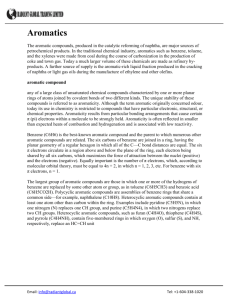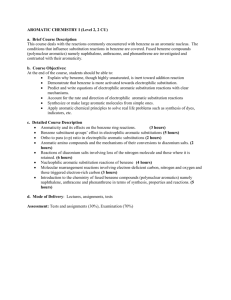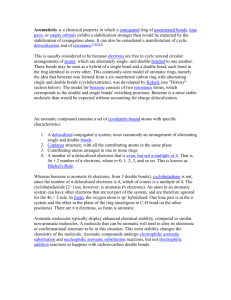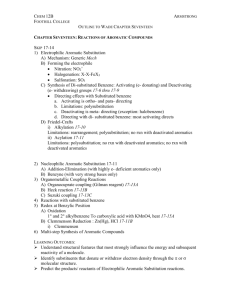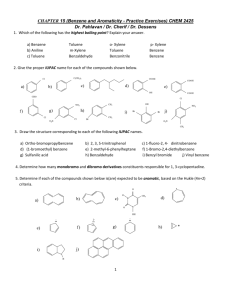Aromatic Compounds - URI Department of Chemistry
advertisement
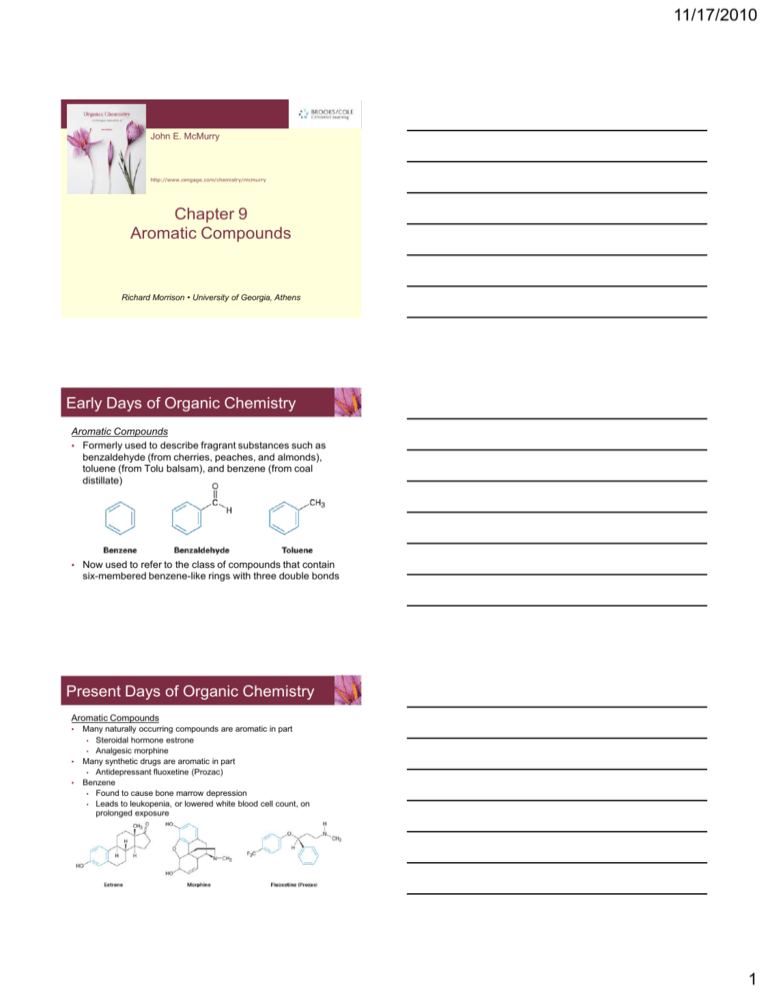
11/17/2010 John E. McMurry http://www.cengage.com/chemistry/mcmurry Chapter 9 Aromatic Compounds Richard Morrison • University of Georgia, Athens Early Days of Organic Chemistry Aromatic Compounds • Formerly used to describe fragrant substances such as benzaldehyde (from cherries, peaches, and almonds), toluene (from Tolu balsam), and benzene (from coal distillate) • Now used to refer to the class of compounds that contain six-membered benzene-like rings with three double bonds Present Days of Organic Chemistry Aromatic Compounds • • • Many naturally occurring compounds are aromatic in part • Steroidal hormone estrone • Analgesic morphine Many synthetic drugs are aromatic in part • Antidepressant fluoxetine (Prozac) Benzene • Found to cause bone marrow depression • Leads to leukopenia, or lowered white blood cell count, on prolonged exposure 1 11/17/2010 9.1 Naming Aromatic Compounds Aromatic substances have acquired nonsystematic names • Nonsystematic names are discouraged but allowed by IUPAC • Common name for methylbenzene is toluene Common name for hydroxybenzene is phenol • Common name for aminobenzene is aniline • Naming Aromatic Compounds Naming Aromatic Compounds Monosubstituted Benzenes • Systematically named in same manner as other hydrocarbons • – benzene used as parent name • • • C6H5Br is bromobenzene C6H5NO2 is nitrobenzene C6H5CH2CH2CH3 is propylbenzene 2 11/17/2010 Naming Aromatic Compounds Arenes • Alkyl-substituted benzenes • Named depending on the size of the alkyl group • Alkyl substituent smaller than the ring (6 or fewer carbons), named as an alkyl substituted benzene • Alkyl substituent larger than the ring (7 or more carbons), named as a phenyl-substituted alkane Phenyl • Derived from the Greek pheno (“I bear light”) • Michael Faraday discovered benzene in 1825 from the oily residue left by illuminating gas used in London street lamps • Used for the –C6H5 unit when the benzene ring is considered as a substituent (Greek phi) • Abbreviated as Ph or Naming Aromatic Compounds Benzyl • Used for the C6H5CH2– group Naming Aromatic Compounds Disubstituted benzenes • Named using one of the prefixes ortho- (o-) 1. • 2. meta- (m-) • 3. Ortho-disubstituted benzene has two substituents in a 1,2 relationship Meta-disubstituted benzene has its substituents in a 1,3 relationship para- (p-) • Para-disubstituted benzene has its substituents in a 1,4 relationship 3 11/17/2010 Naming Aromatic Compounds Benzenes with more than two substituents • • Named by numbering the position of each so that the lowest possible numbers are used The substituents are listed alphabetically when writing the name Any of the monosubstituted aromatic compounds in Table 8.1 can serve as a parent name, with the principal substituent (-OH in phenol or –CH3 in toluene) attached to C1 on the ring 9.2 Structure and Stability of Benzene Benzene • Benzene is unsaturated • Benzene is much less reactive than typical alkene and fails to undergo the usual alkene reactions • • Cyclohexene reacts rapidly with Br2 and gives the addition product 1,2-dibromocyclohexane Benzene reacts only slowly with Br2 and gives the substitution product C6H5Br Structure and Stability of Benzene A quantitative idea of benzene’s stability is obtained from heats of hydrogenation • Benzene is 150 kJ/mol (36 kcal/mol) more stable than might be expected for “cyclohexatriene” 4 11/17/2010 Structure and Stability of Benzene Carbon-carbon bond lengths and angles in benzene • • All carbon-carbon bonds are 139 pm in length • Intermediate between typical C-C single bond (154 pm) and typical double bond (134 pm) • Electrostatic potential map shows that the electron density in all six carbon-carbon bonds is identical Benzene is planar • All C-C-C bond angles are 120 • All six carbon atoms are sp2-hybridized with p orbital perpendicular to the plane of the ring Structure and Stability of Benzene All six carbon atoms and all six p orbitals in benzene are equivalent • Each p orbital overlaps equally well with both neighboring p orbitals, leading to a picture of benzene in which the six electrons are completely delocalized around the ring • Benzene is a hybrid of two equivalent resonance forms • • Neither form is correct by itself The true structure of benzene is somewhere in between the two resonance forms Structure and Stability of Benzene Six p atomic orbitals combine in a cyclic manner, six benzene molecular orbitals result • The three lower-energy molecular orbitals, denoted 3, are bonding combinations • 2 and 3 1, 2, and have the same energy and are said to be degenerate 5 11/17/2010 Structure and Stability of Benzene • The three higher-energy molecular orbitals, denoted 5 • , and 6 4 , , are antibonding combinations 4 and 5 have the same energy and are said to be degenerate Structure and Stability of Benzene • 3 and 4 have nodes passing through ring carbon atoms, therefore no electron density on these carbons • The six p electrons occupy the three bonding molecular orbitals and are delocalized over the entire conjugated system 9.3 Aromaticity and the Hückel 4n + 2 Rule Benzene and other benzene-like aromatic molecules share similar characteristics: • Benzene is cyclic and conjugated • Benzene is unusually stable, it is 150 kJ/mol (36 kcal/mol) more stable than might be expected • Benzene is planar and has the shape of a regular hexagon. All bond angles are 120º, all carbon atoms are sp2hybridized, and all carbon-carbon bond lengths are 139 pm • Benzene undergoes substitution reactions that retain the cyclic conjugation rather than electrophilic addition reactions that would destroy the conjugation • Benzene is a resonance hybrid whose structure is intermediate between two line-bond structures 6 11/17/2010 Aromaticity and the Hückel 4n + 2 Rule The Hückel 4n + 2 rule • Theory devised in 1931 by the German physicist Erich Hückel • • • A molecule is aromatic only if it has a planar, monocyclic system of conjugation and contains a total of 4n + 2 electrons, where n is an integer (n = 0, 1, 2, 3,…) Only molecules with 2, 6, 10, 14, 18,… electrons can be aromatic Molecules with 4n electrons (4, 8, 12, 16,…) can not be aromatic, said to be antiaromatic because delocalization of their electrons would lead to their destabilization Aromaticity and the Hückel 4n + 2 Rule Examples of the Hückel 4n + 2 rule • Cyclobutadiene • Contains four electrons localized into two double bonds rather than delocalized around the ring • Antiaromatic • Highly reactive • Shows none of the properties associated with aromaticity • Not prepared until 1965 Aromaticity and the Hückel 4n + 2 Rule • Benzene • • Contains six Aromatic electrons (4n + 2 = 6 when n = 1) 7 11/17/2010 Aromaticity and the Hückel 4n + 2 Rule • Cyclooctatetraene • Contains eight electrons The electrons are localized onto four double bonds rather than delocalized around the ring Not aromatic • • • • • The molecule is tub-shaped rather than planar It has no cyclic conjugation because neighboring p orbitals do not have the necessary parallel alignment for overlap Resembles an open-chain polyene in its reactivity Aromaticity and the Hückel 4n + 2 Rule Energy Levels of Cyclic Conjugated Molecules (4n + 2 Electrons) • There is always a single lowest-lying MO, above which the MOs come in degenerate pairs • When electrons fill the various molecular orbitals, one pair of electrons fills the lowest-lying orbital and two pairs of electrons fill each of the n successive energy levels – a total of 4n + 2. Any other number would leave a bonding energy level partially unfilled Aromaticity and the Hückel 4n + 2 Rule • Energy levels of the six benzene molecular orbitals • The lowest-energy MO, 1, occurs single and contains a pair of electrons • 2 and 3, are degenerate, and it takes two pairs of electrons to fill them • The result is a stable six- -electron aromatic molecule with filled bonding orbitals 8 11/17/2010 9.4 Aromatic Ions and Aromatic Heterocycles Ions and heterocyclic compounds can also be aromatic Aromatic Ions and Aromatic Heterocycles Aromatic Ions • There are three ways in which the hydrogen might be removed from cyclopenta-1,3-diene and cyclohepta-1,3,5triene • • • The hydrogen can be removed with both electrons (H:-) leaving a carbocation The hydrogen can be removed with one electron (H.) leaving a carbon radical The hydrogen can be removed with no electrons (H+) leaving a carbon anion, or carbanion Aromatic Ions and Aromatic Heterocycles 4n + 2 rule predicts cyclopentadienyl anion and cycloheptatrienyl cation to be aromatic 9 11/17/2010 Aromatic Ions and Aromatic Heterocycles Aromatic cyclopentadienyl anion, showing the cyclic conjugation and six electrons in five p orbitals Aromatic cycloheptatrienyl cation, showing the cyclic conjugation and six electrons in seven p orbitals a) b) Aromatic Ions and Aromatic Heterocycles Aromatic Heterocycles • A cyclic compound that contains atoms of two or more different elements in its ring, usually carbon along with nitrogen, oxygen, or sulfur • Pyridine is much like benzene in its electron structure • • A six-membered heterocycle with nitrogen in its ring Each of the five sp2-hybridized carbons has a p orbital perpendicular to the plane of the ring and each p orbital contains one electron Aromatic Ions and Aromatic Heterocycles • The nitrogen atom is also sp2-hybridized and has one electron in a p orbital, bringing the total to six electrons • The nitrogen lone pair electrons are in an sp2 orbital in the plane of the ring and are not involved with the aromatic system 10 11/17/2010 Aromatic Ions and Aromatic Heterocycles • Pyrimidine is much like benzene in its electron structure • Has two nitrogen atoms in a six-membered, unsaturated ring 2 • Both nitrogens are sp -hybridized, and each contributes one electron to the aromatic system Aromatic Ions and Aromatic Heterocycles • Pyrrole is a five membered heterocycle with six electrons • Aromatic • Each of the sp2-hybridized carbons contributes one electron • The sp2-hybridized nitrogen atom contributes the two electrons from its lone pair, which occupies a p orbital Aromatic Ions and Aromatic Heterocycles • Imidazole is an analog of pyrrole that has two nitrogen atoms in a five-membered, unsaturated ring • Both nitrogens are sp2-hybridized • • One nitrogen is in a double bond and contributes only one electron to the aromatic system The other nitrogen is not in a double bond and contributes two from its lone pair 11


